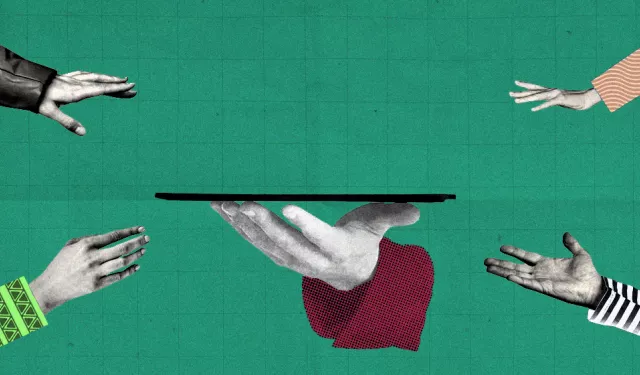
Tales of the welfare state and our old house
The recent amendments to the old rent law, which shattered arrangements that had stood for decades, brought back memories of conversations I often overheard as a child.
I grew up in an aging building governed by that very law, a structure that suffered from neglect and decay. The landlords always blamed the law, saying that if tenants paid “real” rent, both sides would have had the incentive to maintain the building.
It was as if they had adopted rational choice theory, the cornerstone of liberal economic thought, blended with a nostalgic longing for the era of King Farouk. Their stories about the old doorman, dressed in a spotless white galabeya, evoked a bygone order that they claimed was destroyed by the July 1952 “revolution” and the “curse” of the welfare state it ushered in, where citizens were getting basic services and commodities for free or at low cost.
The irony? That very building was eventually sold, and the new owner managed to convince a number of tenants to leave in exchange for “key money”. But the building remained in its deteriorated state. The only difference was that the new tenants paid more, and more crucially, that rent now competed with essential household expenses, from food to education.
Can we say this building reflects Egypt as a whole? I can’t resist the temptation of the analogy.
If you’re surprised by the flurry of legislation—abolishing old rent, privatizing drinking water, and dismantling public education—know that these are not isolated moves. They are connected by a single theoretical vision: abolishing the welfare state. A vision marketed by international financial institutions, yet riddled with contradictions.
The return of commodification
Re-commodification has become one of the most widely circulated terms in contemporary sociology and political economy. To understand the scale of commodification in your life, ask yourself: how many hours must I work to access the goods and services I need?
Until the 1980s, our parents could obtain essential items like oil, sugar, and rice through ration cards, available to all regardless of income. Marie Vannetzel estimates that one could acquire about eight kilograms of these goods for just 63 piasters.
Such low prices indicated that the state acted as a mediator, shielding citizens from the market. Re-commodification, in contrast, places barriers to entering the rationing system or raises prices so much that subsidized goods approach market prices. Citizens are forced to work longer hours to afford food.
Studies from both developed and developing countries have warned of this brutal wave of commodification in recent decades—from turning public health services into commodities to commodifying labor itself, where access to unemployment benefits, social insurance, and healthcare becomes increasingly conditional.
Some argue that the state has withdrawn from its role as protector, handing over that function to the financial sector. Instead of subsidies, millions of low-income people are now pushed towards installment plans and consumer loans. Even limited social protection policies now aim merely to make the poor creditworthy.
The second wave of commodification
We can say that Egypt has been undergoing a full-throttle commodification drive in recent years: from the phased removal of food subsidies and gradual hikes in fuel and electricity prices since 2014, to the 2015 Electricity Law that gave the private sector a five-year window to enter energy production, and the 2019 Social Insurance Law that raised the retirement age and tied benefits to individual savings rather than treating them as social entitlements.
The commodification wave slowed in 2020, likely due to the shock of the COVID-19 pandemic. The state even leaned towards offering new benefits, like a temporary unemployment allowance for informal workers. But in the past two years, the wave returned with full force. A new law allowed private firms to compete with the public water company; another privatized state hospitals; and a third abolished the last vestiges of protection for old rent housing.
This is in addition to gradual commodification policies over the past decade: turning youth centers into high-fee clubs, leaving public green spaces to private restaurants, and sudden hikes in government fees and medicine prices.
In short, heads of households now need to earn tens of thousands of pounds just to stay afloat and avoid falling below the middle-class threshold. The problem? In Egypt, as in many developing countries, you won’t easily find a job.
Some may point to declining unemployment rates as proof that jobs exist. But regardless of how that indicator is calculated, what matters in a commodified economy is not just having a job, but having one that pays well.
In a society where everything is priced freely, money becomes the dominant mediator. And such jobs are scarce in Egypt, where informal employment is the main source of hiring. This means employers operate outside any legal obligations to protect workers.
Even in the formal economy, and in the presence of strong unions, enforcement is lacking. The Journalists Syndicate, for example, still can’t force many newspapers to implement the minimum wage, relying instead on sporadic state stipends.
The problem isn’t limited to employment. In an economy where you can’t access your rights without money, inflation is devastating. We saw this during the currency flotation waves of 2022 to 2024. And we’re still exposed. With foreigners holding about 42% of Egypt’s domestic debt, one of the highest shares in emerging markets, the exchange rate is acutely sensitive to global, regional, or local shocks.
Why do they hate social welfare?
Criticizing commodification doesn’t mean ignoring the flaws of de-commodified systems. Take Adel Imam’s 1985 film “Ramadan Above the Volcano” as one of the clearest artistic depictions of that model’s contradictions. It captures the disillusionment of a generation ready to be seduced by neoliberal promises.
The film—with its comedic tone—portrays a centralized state unable to oversee the hundreds of daily manipulations people use to game the system. From the Tahrir Complex lift operator who claims the elevator is out of service except for the lucky few, to the baker who declares the subsidized bread sold out before the day begins, forcing customers to buy the expensive kind, to the state water company that officially offers home delivery, even as its service is plagued by constant outages. Hence, Adel Imam appears on the poster carrying a water can, searching for an alternative source of water.
The old welfare state model was cornered between two failures: the state’s insufficient financial resources to support the subsidy system, and the black market’s resistance to fixed prices. These failures still persist.
When I interviewed urban researcher Yehia Shawkat in the “Hard Questions” program whether we could reintroduce old rent laws today, he answered decisively that with the current scarcity of rental units, real estate actors would resist by imposing under-the-table key money.
On the other hand, the commodification model is deeply flawed. It doesn’t merely shrink the state’s social role; it actively works to convert social protection into cash payments, under the slogan “just give the poor money and let them buy what they want” even in an environment where money loses value daily and laws offer no guarantee to peg pensions to inflation.
It seems we’ve been swept into the neoliberal solution by replacing small household subsidies with micro-debt. In the past five years, non-bank financing has exploded, now serving over 2 million clients. Everything, from cars to school fees, is being paid in installments. But these borrowers face enormous pressure when interest rates rise, and millions more are excluded entirely because they don’t meet credit criteria.
Perhaps these policies have exhausted their capacity to help. That’s not just my conclusion—surprisingly, it’s one voiced by Hania Sholkamy in her interview with Al Manassa.
It was Sholkamy who originally proposed the Takaful and Karama cash-transfer scheme—a program the state later adopted and now touts as its flagship poverty-alleviation success. Yet she now advocates a shift away from targeted aid towards broader, universal policies modeled after the old social welfare framework. She proposes unconditional grants for all students enrolled in public education. Yehia Shawkat, meanwhile, calls for rent-gap subsidies to shield tenants under the old rent system from the pressures of real estate speculation.
It’s time to revolt against neoliberalism
We desperately need to break with the neoliberal logic that has governed us since the 1990s; the idea that money must be the primary means to access basic rights like food and shelter. Even Western societies are now critiquing this logic, so how can it be applied in developing economies where labor markets are deeply distorted?
We need a broad societal dialogue on how to return to policies of social welfare, but with a new framework—one that is more democratic and able to resist black-market practices, more inclusive, and capable of mobilizing resources to fund support programs.
Published opinions reflect the views of its authors, not necessarily those of Al Manassa.
